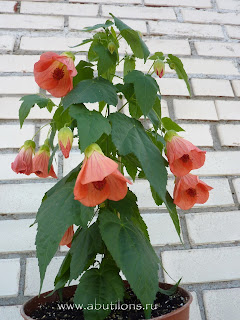Почему из семян абутилонов не вырастают их копии?
Как известно, некоторые растения легко переопыляются между собой, самоопыляются, обмениваются пыльцой внутри сорта (например, томаты). Другим же (например, некоторым сортам вишни) для получения плода нужен совершенно определённый и зачастую очень отличающийся опылитель. Также у ряда растений есть защитный эволюционный механизм — встроенная система, не позволяющая им самоопыляться или опыляться схожим растением, дабы не регрессировать и вырождаться, а наоборот, двигаться вперёд.
Что касается гибридов абутилона, то они имеют довольно навороченную генетическую солянку, из-за которой при перекрёстном опылении потомство получается с широким набором признаков, часто не наблюдаемых у непосредственных родительских растений. Сеянцы одной семенной коробочки могут быть абсолютно разными и лишь отдельными чертами (например, жилкованием или формой венчика) напоминающими кого-то из родителей. Или же они могут быть схожими по цвету (например, все рыжие или розоватые) и строению (все a la Тигровый глаз). Но чтобы из семян авторского или пчелиного опыления выросли копии материнского (или отеческого растения) — это сильно вряд ли! Поэтому, продавая семена, правильнее писать "семена с абутилона N", а не "семена абутилона N".
К тому же, самоопыление абутилона происходит довольно редко. Есть подозрение, что ряд гибридов вообще не способен на самоопыление. А жаль! Я попыталась самоопылить и скрестить между собой одинаковые гибриды, дабы посмотреть, не получится ли их размножить семенами. Я была готова на многолетнюю выборку схожих растений, но увы: пока что все мои опыления такого рода провалились.
Что касается сортовых семян абутилонов Белла, то скорее всего их получили методом выборки схожего по качествам потомства, полученного от разных (!) родителей (например, от белых, розовых или коралловых). Именно поэтому при посеве семян, например, Bella Vanilla, вырастают ванильные абутилоны, чья форма, строение и характер роста всё же немного разнятся.
Т. о. идентичное родителям потомство абутилона получается лишь при вегетативном размножении (черенками) или клонировании (меристемой). Поэтому, если вы хотите приобрести определённый абутилон, приобретайте его черенки, а не семена. А если же вы хотите совершенно новые, единственные в своём роде растения — приобретайте семена. Лично для меня ождание цветения нового гибрида по волнительности сравнимо лишь с открыванием подарка от Деда Мороза... 🎁
Заходите в гости: vk.com/abutilons, www.abutilons.ru, @abutilonier.alina (Instagram)



































